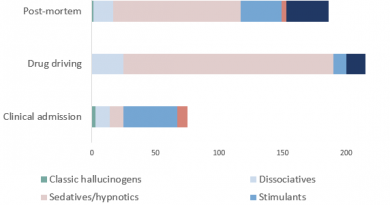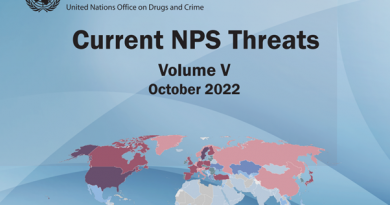UNODC EWA: Nitazenes – a new group of synthetic opioids emerges
VIENNA, Austria – February 2024: Nitazenes are a group of synthetic opioids that have emerged in recent years. They are analogues of the internationally controlled substances clonitazene and etonitazene. Isotonitazene was the first nitazene not under international control (at that time) reported to the UNODC Early Warning Advisory on New Psychoactive Substances (EWA). Since that first report in 2019, the number of nitazenes reported has increased significantly from one substance in 2019 to 13 different nitazenes in 2023, some of which are highly potent. Up to February 2024, nitazenes have been reported from Asia, Europe, North America, Oceania, and South America.
Figure 1: Number of unique fentanyl analogues and nitazenes reported to the UNODC EWA, 2012-2023*

Source: UNODC Early Warning Advisory on New Psychoactive Substances, 2024. Note: synthetic opioids belonging to other chemical groups apart from fentanyl analogues and nitazenes are not represented in this graph.
*Note: Data for 2023 is preliminary.
There are clear signs of a rapid emergence and spread of nitazenes: Since 2021, the number of unique nitazenes reported from European countries has been higher each year than the number of unique fentanyl analogues. While North America continues to report high numbers of unique fentanyl analogues, the number of unique nitazenes identified is similar to Europe. The countries reporting the highest numbers of unique nitazenes, in descending order, are the United States, Canada, Latvia, Estonia, the United Kingdom, Sweden, and Germany. Since 2019, the most frequently reported nitazenes include isotonitazene, metonitazene, protonitazene, etonitazepyne and etazene, all of which have since been placed under international control.
Figure 2: Number of countries and territories reporting fentanyl analogues and nitazenes, by year*

Source: UNODC Early Warning Advisory on New Psychoactive Substances, 2024. Note: synthetic opioids belonging to other chemical groups apart from fentanyl analogues and nitazenes are not represented in this graph.
*Note: Data for 2023 is preliminary.
Nitazenes have also been reported in toxicology casework. Since 2019, 179 toxicology cases involving nitazenes (male n=135, female n=43, n=1 unknown) have been reported to the UNODC EWA, 89% of them relating to post-mortem cases. Out of all cases involving nitazenes, in 27 cases, a nitazene was the only substance reported and assessed to be causal or contributory to the negative health outcome.
For further information, please see:
UNODC Early Warning Advisory – Current NPS Threats Voume VI
UNODC Early Warning Advisory – Summary Dashboard
UNODC-SMART: Emergence of the new synthetic opioid isotonitazene




